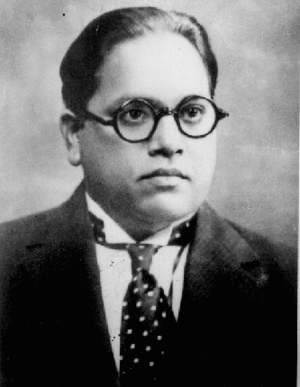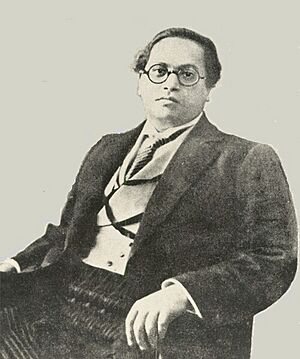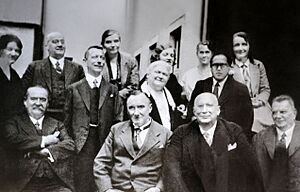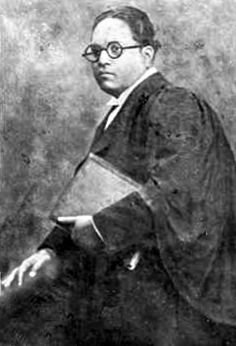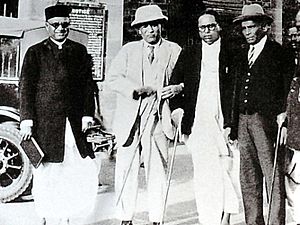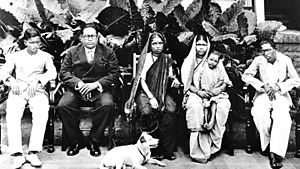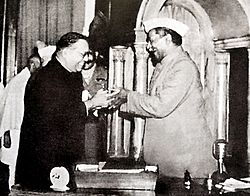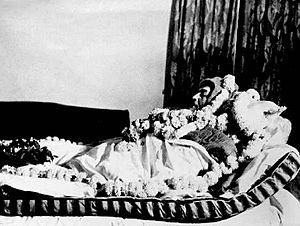B. R. Ambedkar facts for kids
Quick facts for kids
B. R. Ambedkar
|
|
|---|---|
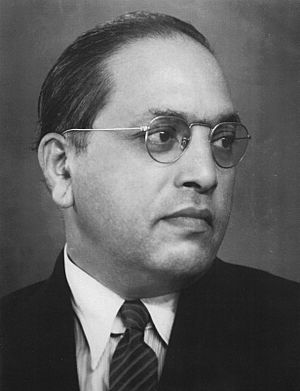
Ambedkar in the 1950s
|
|
| Member of Parliament of Rajya Sabha for Bombay State | |
| In office 3 April 1952 – 6 December 1956 |
|
| President | Rajendra Prasad |
| Prime Minister | Jawaharlal Nehru |
| 1st Minister of Law and Justice | |
| In office 15 August 1947 – 6 October 1951 |
|
| President | Rajendra Prasad |
| Governor General | Louis Mountbatten C. Rajagopalachari |
| Prime Minister | Jawaharlal Nehru |
| Preceded by | Position established |
| Succeeded by | Charu Chandra Biswas |
| Chairman of the Constitution Drafting Committee | |
| In office 29 August 1947 – 24 January 1950 |
|
| Member of the Constituent Assembly of India | |
| In office 9 December 1946 – 24 January 1950 |
|
| Constituency | • Bengal Province (1946–47) • Bombay Province (1947–50) |
| Minister of Labour in Viceroy's Executive Council | |
| In office 22 July 1942 – 20 October 1946 |
|
| Governor General | The Marquess of Linlithgow The Viscount Wavell |
| Preceded by | Feroz Khan Noon |
| Leader of the Opposition in the Bombay Legislative Assembly | |
| In office 1937–1942 |
|
| Member of the Bombay Legislative Assembly | |
| In office 1937–1942 |
|
| Constituency | Bombay City (Byculla and Parel) General Urban |
| Member of the Bombay Legislative Council | |
| In office 1926–1937 |
|
| Personal details | |
| Pronunciation | Bhīmrāo Rāmjī Āmbēḍkar |
| Born |
Bhiva Ramji Sakpal
14 April 1891 Mhow, Central India Agency, British India (now Madhya Pradesh, India) |
| Died | 6 December 1956 (aged 65) New Delhi, India |
| Resting place | Chaitya Bhoomi, Mumbai, India 19°01′30″N 72°50′02″E / 19.02500°N 72.83389°E |
| Political party | • Independent Labour Party • Scheduled Castes Federation |
| Other political affiliations |
• Republican Party of India |
| Spouses |
|
| Children | Yashwant Ambedkar |
| Relatives | See Ambedkar family |
| Residences | • Rajgruha, Mumbai, Maharashtra • 26 Alipur Road, New Delhi |
| Alma mater |
|
| Profession |
|
| Known for | Dalit rights movement Heading committee drafting Constitution of India Dalit Buddhist movement |
| Awards | Bharat Ratna (posthumously in 1990) |
| Signature |  |
| Nickname | Babasaheb |
Bhimrao Ramji Ambedkar (born 14 April 1891 – died 6 December 1956) was an important Indian leader. He was a jurist (a legal expert), an economist, a social reformer, and a politician. He led the committee that wrote the Constitution of India. He also served as India's first Minister of Law and Justice. Later in his life, he started the Dalit Buddhist movement after leaving Hinduism.
Ambedkar studied economics at Columbia University in the US and the London School of Economics in the UK. He earned advanced degrees from both. He also trained to be a lawyer in London. Early in his career, he worked as an economist, professor, and lawyer. Later, he focused on politics. He fought for the rights and freedom of Dalits, who were treated as "untouchables." In 1956, he converted to Buddhism, inspiring many Dalits to do the same.
In 1990, Ambedkar received the Bharat Ratna. This is India's highest award for civilians. His followers often say Jai Bhim, which means "Hail Bhim," to honor him. He is also known by his nickname Babasaheb, which means "Respected Father."
Contents
Early Life and Challenges
Ambedkar was born on 14 April 1891 in Mhow, a town in what is now Madhya Pradesh. He was the 14th and last child in his family. His father, Ramji Maloji Sakpal, was an army officer. His family came from the Mahar caste. This caste was considered "untouchable" at the time. People from this caste faced a lot of unfair treatment and discrimination.
Even though Ambedkar and other "untouchable" children went to school, they were kept separate. Teachers often ignored them. They were not allowed to sit inside the classroom. When they needed water, someone from a higher caste had to pour it for them. They were not allowed to touch the water or the pot. Ambedkar later wrote about this, calling it "No peon, No Water" because if the school helper wasn't there, he couldn't drink. He also had to bring his own mat to sit on and take it home every day.
In 1894, Ambedkar's father retired. The family moved to Satara two years later. Soon after, Ambedkar's mother died. His aunt took care of the children. Life was hard for them. Out of all his brothers and sisters, only Bhimrao passed his exams and went to high school. His family's original last name was Sakpal. But his father registered him as Ambadawekar at school, which meant "from Ambadawe village." His teacher, Krishnaji Keshav Ambedkar, changed his last name to 'Ambedkar' in the school records.
Ambedkar's Education Journey
High School and College
In 1897, Ambedkar's family moved to Mumbai. There, he was the only "untouchable" student at Elphinstone High School. In 1906, when he was about 15, he married nine-year-old Ramabai. This marriage was arranged by their parents, as was common then.
In 1907, he passed his high school exams. The next year, he joined Elphinstone College, which was part of the University of Bombay. He was the first person from his Mahar caste to go to college. When he passed his English exams, his community celebrated. They saw it as a huge achievement. A family friend gave him a book about the Buddha.
By 1912, he earned his degree in economics and political science from Bombay University. He planned to work for the Baroda state government. But his father became ill, and Ambedkar had to return to Mumbai. His father died in February 1913.
Studying in America and England
In 1913, at age 22, Ambedkar received a scholarship from the Baroda State. This scholarship allowed him to study at Columbia University in New York City. He earned his first master's degree in June 1915, focusing on economics. He also studied sociology, history, philosophy, and anthropology. His thesis was about Ancient Indian Commerce.
In 1916, he completed another master's thesis. He also gave a paper called Castes in India: Their Mechanism, Genesis and Development. He received his Ph.D. in economics from Columbia in 1927.
In October 1916, he started studying law at Gray's Inn in London. At the same time, he enrolled at the London School of Economics for another doctorate. In June 1917, he had to return to India because his scholarship ended. He later got permission to go back to London. He completed a master's degree in 1921. His thesis was about "The problem of the rupee." In 1923, he earned a D.Sc. in Economics from the University of London. In the same year, he became a lawyer.
Fighting Against Untouchability
After his studies, Ambedkar worked as a military secretary for a short time. He then tried different jobs to support his family. He was a private tutor and an accountant. He even started a business, but it failed when clients found out he was an "untouchable." In 1918, he became a professor at Sydenham College of Commerce and Economics in Mumbai. Students liked him, but other professors didn't want to share a drinking water jug with him.
Ambedkar spoke to the Southborough Committee, which was planning a new law for India. He argued for separate voting groups and reserved seats in government for "untouchables" and other religious groups. In 1920, he started a weekly newspaper called Mooknayak (Leader of the Silent).
He also became a successful lawyer. In 1926, he won a case defending non-Brahmin leaders. This victory was very important for him and his clients. While working as a lawyer, he tried to help "untouchables" get an education and improve their lives. He started the Bahishkrit Hitakarini Sabha to help "outcastes" with education and social progress. He also launched newspapers like Mook Nayak and Bahishkrit Bharat to defend Dalit rights.
By 1927, Ambedkar began strong movements against untouchability. He led public marches to open up public drinking water sources for everyone. He also fought for the right to enter Hindu temples. He led a satyagraha (non-violent protest) in Mahad. This protest was to allow the "untouchable" community to use the town's main water tank. In late 1927, Ambedkar publicly criticized the Hindu text, the Manusmriti. He said it supported caste discrimination. He led thousands of followers to burn copies of this ancient text. Because of this, 25 December is now celebrated as Manusmriti Dahan Din (Manusmriti Burning Day) by his followers.
In 1930, Ambedkar started the Kalaram Temple movement. About 15,000 volunteers marched to the Kalaram Temple in Nashik. They wanted to enter the temple for the first time. But when they reached the gates, temple authorities closed them.
The Poona Pact
In 1932, the British government planned to create separate voting groups for "Depressed Classes" (untouchables). Mahatma Gandhi strongly disagreed. He feared it would divide the Hindu community. Gandhi protested by fasting while in jail.
After Gandhi's fast, other leaders met with Ambedkar. On 25 September 1932, Ambedkar and Madan Mohan Malaviya signed an agreement called the Poona Pact. This agreement gave "Depressed Classes" more reserved seats in the legislatures. They received 148 seats instead of the 71 seats first offered. This pact helped ensure that "untouchables" could choose their own candidates within a larger voting system.
Political Career and Social Reforms
In 1935, Ambedkar became the principal of the Government Law College, Bombay, for two years. He also became the chairman of Ramjas College in Delhi. He built a house in Mumbai and filled his library with over 50,000 books. His first wife, Ramabai, died that same year after a long illness.
Ambedkar had refused to let his wife go on a pilgrimage to a Hindu temple because of how "untouchables" were treated. He told her he would create a new holy place for her. At a conference in October 1935, Ambedkar announced he would convert to a different religion. He urged his followers to leave Hinduism. He repeated this message at many public meetings.
In 1936, Ambedkar started the Independent Labour Party. This party won several seats in the 1937 Bombay election.
Ambedkar published his book Annihilation of Caste in 1936. In it, he strongly criticized Hindu religious leaders and the caste system. He also criticized Gandhi's views on the caste system. Ambedkar also fought against the khoti system, where land collectors exploited farmers. In 1937, he proposed a bill to end this system.
Ambedkar also served as a minister for labor in the Viceroy's Executive Council. He criticized the Congress party's policies, saying they oppressed his community more than Indian Muslims. He also joined Muhammad Ali Jinnah in criticizing the Congress party.
After the Muslim League demanded a separate country called Pakistan in 1940, Ambedkar wrote a book called Thoughts on Pakistan. He suggested that Hindus should agree to Pakistan. He believed that the borders of Punjab and Bengal should be redrawn to separate Muslim and non-Muslim areas. His book had a big impact on Indian politics.
Ambedkar changed his political party to the Scheduled Castes Federation. He was later elected to the Constituent Assembly of Bengal. After India became independent, Mahatma Gandhi recommended Ambedkar to Jawaharlal Nehru for a position in the new government. Ambedkar became India's first law minister of India.
Ambedkar ran for election in 1952 but lost. He then became a member of the Rajya Sabha (one of India's parliamentary houses). He tried to enter the Lok Sabha (the other house) again in 1954 but did not win. He died before the next general election in 1957.
Ambedkar also criticized some practices in Islam in South Asia. He condemned child marriage and the mistreatment of women in Muslim society.
Drafting India's Constitution
When India became independent on 15 August 1947, Prime Minister Jawaharlal Nehru asked Ambedkar to be the first Law Minister. Two weeks later, he was chosen to lead the committee that would write the Constitution of India.
The Indian Constitution protects many civil liberties for citizens. These include freedom of religion, ending untouchability, and stopping all forms of discrimination. Ambedkar strongly argued for economic and social rights for women. He also helped create a system of reservations. This system sets aside jobs in government, schools, and colleges for members of scheduled castes, scheduled tribes, and Other Backward Class. This is like affirmative action and helps groups that faced disadvantages. Indian lawmakers hoped these measures would reduce inequalities and create more opportunities. The Constitution was officially adopted on 26 November 1949.
In 1953, Ambedkar expressed some concerns about the Constitution. He said he was just a "hack" who did what he was asked. He even said he would be the first to burn it if it didn't suit anyone.
Ambedkar's Economic Ideas
Ambedkar was the first Indian to earn a doctorate in economics from another country. He believed that making India more industrial and improving agriculture would help the economy grow. He thought that investing in farming was very important for India. According to some, his ideas helped India achieve food security.
Ambedkar also believed in national economic and social development. He emphasized the importance of education, public health, and good housing. His DSc thesis, The problem of the Rupee: Its Origin and Solution (1923), looked at why the value of the Indian currency was falling. He suggested using a modified gold standard to make currency rates stable.
He also studied how the British government managed finances in India. He believed that governments should use money wisely and fairly for the public good.
In 1951, Ambedkar helped create the Finance Commission of India. He was against taxing low-income groups. He also played a role in land reform and economic development. He believed the caste system, with its divisions, stopped people and money from moving freely. He thought this hurt the economy. He supported a free economy with a stable currency. He also stressed equal rights for women for economic growth.
Ambedkar believed that too much agricultural land was not being used well. He thought that many people working in agriculture was a problem. So, he supported industrializing the economy. This would allow farm workers to find other useful jobs.
Ambedkar was a professional economist until 1921. He wrote three important books on economics:
- Administration and Finance of the East India Company
- The Evolution of Provincial Finance in British India
- The Problem of the Rupee: Its Origin and Its Solution
The Reserve Bank of India (RBI), which is India's central bank, was based on ideas Ambedkar presented to a special commission.
Family Life
Ambedkar's first wife, Ramabai, died in 1935. After finishing the draft of India's constitution in the late 1940s, he had health problems. He had trouble sleeping and pain in his legs. He went to Mumbai for treatment. There, he met Sharada Kabir, a doctor. He married her on 15 April 1948. Doctors suggested he needed a companion who could cook well and had medical knowledge. She took the name Savita Ambedkar and cared for him for the rest of his life. Savita Ambedkar, also known as 'Mai', died in 2003 at age 93.
Conversion to Buddhism
Around 1950, Ambedkar became very interested in Buddhism. He traveled to Ceylon (now Sri Lanka) for a Buddhist meeting. When he opened a new Buddhist temple near Pune, he announced he was writing a book on Buddhism. He said he would officially convert to Buddhism once it was finished. He visited Burma twice in 1954 for Buddhist conferences. In 1955, he founded the Buddhist Society of India. In 1956, he finished his last book, The Buddha and His Dhamma, which was published after his death.
After meeting with a Buddhist monk, Ambedkar organized a public ceremony in Nagpur on 14 October 1956. He and his wife formally converted to Buddhism. Then, he converted about 500,000 of his followers who were gathered there. He gave them 22 vows to follow. He then traveled to Kathmandu, Nepal, for another Buddhist conference.
Death and Legacy
Ambedkar had diabetes since 1948. His health got worse in 1955. Three days after finishing his last book, The Buddha and His Dhamma, Ambedkar died in his sleep on 6 December 1956, at his home in Delhi.
A Buddhist cremation ceremony was held on 7 December at Dadar Chowpatty beach in Mumbai. Half a million people attended. On 16 December 1956, another conversion program was held at the same place for those who attended the cremation.
Ambedkar was survived by his second wife, Savita Ambedkar, and his son, Yashwant Ambedkar. Both continued his social and religious work. Many of Ambedkar's unfinished writings were found and published later. These include Waiting for a Visa, an autobiography, and The Untouchables, or the Children of India's Ghetto.
A memorial for Ambedkar is at his Delhi home, 26 Alipur Road. His birthday, Ambedkar Jayanti, is a public holiday in many Indian states. He was given India's highest civilian honor, the Bharat Ratna, in 1990 after his death.
Every year, on his birth and death anniversaries, and on Dhamma Chakra Pravartan Din (14 October) in Nagpur, at least half a million people gather to honor him in Mumbai. Many bookshops are set up, selling his books. His famous message to his followers was: "educate, agitate, organise!"
Ambedkar's Impact and Views

Ambedkar's work as a social and political reformer greatly influenced modern India. His ideas have shaped India's policies on economy, education, and affirmative action. His reputation as a scholar led to him becoming India's first law minister and the head of the Constitution drafting committee. He strongly believed in individual freedom and criticized the caste system. His criticism of Hinduism as the basis of the caste system made him controversial. His conversion to Buddhism also renewed interest in Buddhist philosophy in India and beyond.
Many public places are named after him, like the Dr. Babasaheb Ambedkar International Airport in Nagpur. A house in London where he lived is being turned into a museum.
In 2012, a poll voted Ambedkar "the Greatest Indian". He was chosen over other famous leaders. Many economists, like Amartya Sen, have praised his contributions to economics.
In 1967, a large bronze statue of Ambedkar was placed in the Parliament of India. In 1990, a portrait of him was put in the Central Hall of the Parliament House.
Ambedkar's ideas have led to many political parties and groups that are still active in India, especially in Maharashtra. His promotion of Buddhism has also inspired many people in India and other countries. Some Indian Buddhists see him as a Bodhisattva, a person who delays their own nirvana to help others.
Views on Religion
In 1935, Ambedkar said he was born a Hindu but would not die one. He saw Hinduism as an "oppressive religion." He started thinking about converting to another religion. In his book Annihilation of Caste, he argued that to end the caste system, people must reject the authority of Hindu religious texts. He also wrote Riddles in Hinduism, which criticized Hindu religious texts.
Ambedkar believed Christianity could not fight injustices. He wrote that a civil war was needed to end slavery in the United States, not just Christianity. He also criticized some aspects of Islam. He described it as a "close corporation" that separated Muslims from non-Muslims.
He was against "depressed classes" converting to Islam or Christianity. He felt that converting to Islam could lead to "Muslim domination." He also thought converting to Christianity would strengthen British control over India.
He first thought about converting to Sikhism. But he changed his mind when the British government would not guarantee the same privileges for "untouchables" in reserved parliamentary seats if they became Sikhs. On 16 October 1956, just weeks before his death, he converted to Buddhism.
Views on History
Ambedkar believed that the Shudras, a group at the bottom of the traditional Indian social system, were originally part of the higher Kshatriya class. He strongly disagreed with the idea that Aryans invaded India from outside. He called this idea "absurd." He thought the Aryan homeland was India itself. He believed that the ancient Rig Veda text showed Aryans, Dāsa, and Dasyus were competing religious groups, not different peoples.
Views on Communism
Ambedkar shared some ideas with Communism. He agreed that a few powerful people exploited the masses, causing poverty. But he thought exploitation wasn't just about money. He believed cultural exploitation was just as bad, or even worse. He also disagreed with Communists using violence to achieve change. He believed in democratic and peaceful methods.
Ambedkar also opposed the Marxist idea of the state controlling all production and ending private property. He didn't think this would solve society's problems. Instead of the state disappearing, as Marxism suggests, Ambedkar believed the state would always exist. He thought it should actively help society develop.
Works
The Government of Maharashtra has published many of Ambedkar's writings and speeches. Some of his important works include:
- Castes in India: Their Mechanism, Genesis and Development
- Riddles in Hinduism
- The Annihilation of Caste (1936)
- Who Were the Shudras? (1946)
- Pakistan or the Partition of India
- The Buddha and his Dhamma
- Waiting for a Visa (an autobiography)
Images for kids
 In Spanish: B.R. Ambedkar para niños
In Spanish: B.R. Ambedkar para niños


